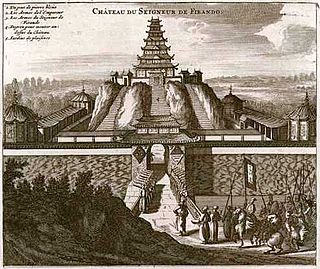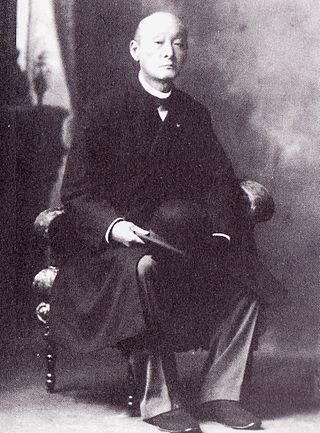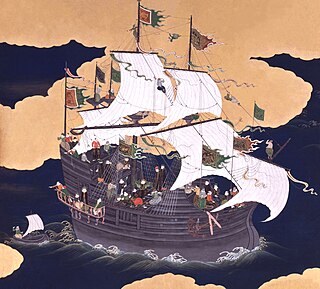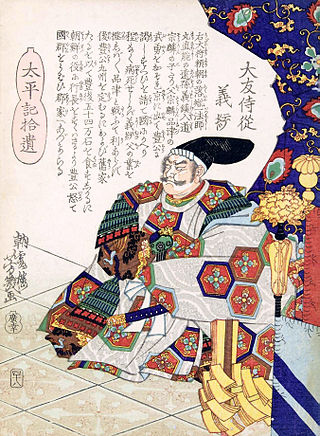
Hirado Castle was the seat of the Matsura clan, the daimyō of Hirado Domain, of Hizen Province, Kyūshū. It is located in present-day Hirado city Nagasaki Prefecture, Japan. It was also known as Kameoka Castle.

Shimazu Yoshihisa was a powerful daimyō and the 16th Chief of Shimazu clan of Satsuma Province, the eldest son of Shimazu Takahisa. He was renowned as a great general, who managed to subjugate Kyushu through the deft maneuvering of his three brothers. Eventually in 1585, Yoshihisa succeeded controlled the entire Kyushu region.

Sō clan were a Japanese clan claiming descent from Taira no Tomomori. The clan governed and held Tsushima Island from the 13th through the late 19th century, from the Kamakura period until the end of the Edo period and the Meiji Restoration.
Gaspar Coelho was a Portuguese Jesuit missionary. He replaced Francisco Cabral as the Superior and Vice-Provincial of the Jesuit mission in Japan during the late 16th century. He catalyzed the disfavor of Toyotomi Hideyoshi against the Jesuit mission in Japan in 1587.

Ōtomo Sōrin, also known as Fujiwara no Yoshishige or Ōtomo Yoshishige, was a Japanese feudal lord (daimyō) of the Ōtomo clan, one of the few to have converted to Roman Catholicism (Christianity). The eldest son of Ōtomo Yoshiaki, he inherited the Funai Domain, on Kyūshū, Japan's southernmost main island, from his father. He is perhaps most significant for having appealed to Toyotomi Hideyoshi to intervene in Kyūshū against the Shimazu clan, thus spurring Hideyoshi's Kyūshū Campaign of 1587.

Matsura Hisanobu was a Japanese daimyō of the late Azuchi–Momoyama period through early Edo period, who ruled the Hirado Domain of Hizen Province. His wife, Sono, was the daughter of the famous Christian daimyo, Ōmura Sumitada.

Nabeshima Naoshige was a warlord of the Sengoku and early Edo periods and progenitor of the Nabeshima lords of the Saga Domain. Naoshige was the second son of Nabeshima Kiyofusa. His mother was the daughter of Ryūzōji Iesumi. He was a vassal of the Ryūzōji clan during the Sengoku period of the 16th century.

Ōmura Sumitada was a Japanese daimyō lord of the Sengoku period. He became famous throughout the country for being the first of the daimyo to convert to Christianity following the arrival of the Jesuit missionaries in the mid-16th century. Following his baptism, he became known as "Dom Bartolomeu". Sumitada is also known as the lord who opened the port of Nagasaki to foreign trade.

Nabeshima clan is a Japanese samurai kin group.

Hirado Domain (平戸藩), also known as Hirado-han, was a domain during the Edo period in Japan. It was located in Hizen Province, which is now part of Nagasaki Prefecture. The han system in Hirado was a political and economic concept that relied on surveys and projected agricultural yields, rather than land area, to define the domain. This system was distinct from the feudalism of the Western world.

Ryūzōji clan was a Japanese kin group which traces its origin to Hizen Province on the island of Kyushu.

Matsura Takanobu or Taqua Nombo was a 16th-century Japanese samurai and 25th hereditary lord of the Matsura clan of Hirado. He was one of the most powerful feudal lords of Kyūshū and one of the first to allow trading with Europeans, particularly the Portuguese, through whom he amassed great profits in the import of western firearms. He was also an early host and patron to the Jesuits, who he hoped would help secure an increase in trade with the Portuguese and other European traders.

Count Matsura Akira was the 12th and final daimyō of Hirado Domain in Hizen Province, Kyūshū, Japan. He was also the 37th hereditary head of the Matsura clan, and a noted tea master. His honorary title was. Hizen-no-Kami.
Matsuura is a Japanese surname. Notable people with the surname include:

Matsura Takanobu was the 3rd daimyō of Hirado Domain in Hizen Province, Kyūshū, Japan. He was also the 28th hereditary head of the Matsura clan.

The Battle of Fukuda Bay in 1565 was the first recorded naval battle between Europeans and the Japanese. A flotilla of samurai under the daimyō Matsura Takanobu attacked two Portuguese trade vessels that had shunned Matsura's port in Hirado and had gone instead to trade at Fukuda, a port belonging to the rival Ōmura Sumitada. The engagement was part of a process of trial and error by the Portuguese traders to find a safe harbour for their carracks in Japan that eventually brought them to Nagasaki.

Portuguese Nagasaki and Ecclesiastical Nagasaki refer to the period during which the city of Nagasaki was under foreign administration, between the years of 1580 and 1587. Formally granted to the Jesuits, a representative of the Portuguese Crown was considered the highest authority in the city when present, as per Portuguese rights of Padroado.

Yokoseura (横瀬浦) is a port located at the northern tip of the Nishisonogi Peninsula on the Japanese island of Kyushu, administratively under Saikai city, Nagasaki Prefecture. It was developed as an entrepot by the Portuguese in 1562 with the permission of the local lord Ōmura Sumitada, but was burned down a year later during a rebellion against Sumitada.
Shōtō-in (松東院) was an early Christian in Japan. By birth Ōmura Sono, she took the Christian name Mencia (メンシア). The fifth daughter of Christian daimyō Ōmura Sumitada, she was the wife of Matsura Hisanobu and the mother of Matsura Takanobu.

Ōtomo Yoshimune was a Japanese daimyō of the Sengoku period, heir of Otomo Sōrin at the head of the Ōtomo clan. He was the eldest son and successor of Otomo Sōrin as lord of the Bungo Province. His mother was an anti-Christian, known today only for the Jesuit epithet for her, Jezebel. His wife was Yoshihiro Kikuhime.



















